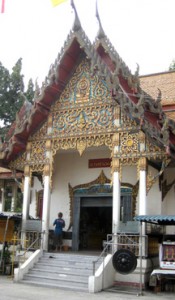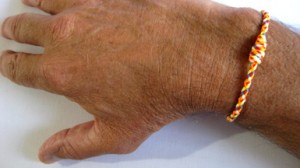Many — and here we’ll take the risk of saying Most — Thais make merit at a wat (temple) periodically. Making merit is the act of taking a small gift to the wat, presenting it to a monk, reflecting on good wishes in the name of others, and receiving a blessing from the monk.
Everyone has his or her favorite wat for tham boon (making merit), which, generally speaking, could be in one’s city of residence or one’s ancestral home. A Thai friend invited WoWasis to accompany her to tham boon at Bangkok’s Wat Mahabut, and the entire ritual was quite interesting. Here are the procedural steps to tham boon:
1) Begin by buying a plastic orange bucket of personal items, from a shop just outside the wat. These buckets can be found for sale for various amounts of money, starting at 60 baht. They contain things like soaps and small towels, flashlights and small umbrellas. When you buy the bucket, you’ll be given a pink envelope in which to put money for the temple. You write your name on the envelope, insert the money, then tape it to the bucket, right beneath several sticks on incense.
2) Inside the wat, there will be a smaller shrine area where one or more monks will be seated. Remove your shoes, climb the steps, and kneel before the monk, placing your bucket in front of you. We of course, didn’t know the ritual, but followed our Thai friend as she bowed and waiied. There was a white cloth with a red stripe before the monk, and our friend placed her bucket on the cloth, wheupon it was taken by the monk (women must place their offereings before the monk, who will never take it from them directly). The monk then began chanting in phrases, our friend repeating after each phrase.
3) A small ewer full of sanctified water and a small bowl were placed in front of us by the monk. As we slowly poured the contents of the ewer into the bowl, the monk sprinkled us with holy water.
4) He then gave each of us a “sai sing,” or holy string, which we later placed around our wrists. This string must be given by the monk, and is traditionally kept on the wrist until it falls off. The sai sing was traditionally white and hand-tied by the monk, but today is pre-tied, and is rolled over the wrist. The monk thanked us, and we bowed and left, taking with us the small bowl of water the monk had just blessed.
5) Immediately outside the monk’s shrine area, there was a tiny garden of statuary surrounding a tree. Our Thai friend instructed us to concentrate on people who were important to us, then slowly pour the contents of the bowl at the base of the tree.
Thus ends the tham boon ritual. But there are other rituals to perform at the wat as well. Wat Mahabut, sits right next to Wat Mae Phra Khanong, the temple dedicated to the legendary ghost. Here, it’s more about animistic beliefs than Buddhism, but for millions in Thailand, the two belef systems are inexorably intertwined. At Wat Mae Phra Khanong, you purchase a small garland of flowers, incense, and some gold leaf. Light the incense, place the garland near the statue of Mae Phra Khanong, then place gold leaf on her. There is a small bowl nearby containing plastic balls, each with a number. Reach inside and take a ball. The number you see corresponds to a fortune that you’ll find on paper, sitting nearby in a cubbyhole. The fortune is in Thai, which your Thai friend will be happy to read for you.
At other shrines in the wat, instead of a bowl of numbered balls, there is a wooden tube of numbered sticks, which you shake until one falls out. That stick has a number painted on it, which again, corresponds to a numbered fortune.
We found the tham boon ritual to be important in terms of understanding out Thai friends better, and were honored that we were invited. Our Thai friend mentioned that she was making merit not only for her family, but for her ancestors, her boyfriend, the family of her boyfriend, and even her boyfriend’s recently deceased dog as well. If you haven’t yet done so, consider asking a Thai friend if he or she will bring you along on the next merit-making trip. It will take only a few minutes, but can add immeasurably to your understanding of how Thais think and feel.
Wat Mahabut and Wat Mae Phra Khanong, are most easily reached by taking the BTS Skytrain to On Nut station. Adjacent to the station, find Sukhumvit Soi 77 and turn right. Take a taxi or motorcycle taxi ¾ kilometer to Soi On Nut 7 and turn left. The wat is at the end of the road, approximately ¼ kilometer.



Leave a Reply